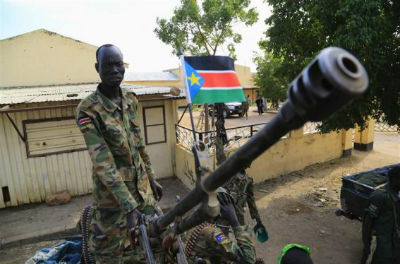![A soldier of the SPLA [Reuters]](http://www.southsudannewsagency.com/wp-content/uploads/2014/05/spla%20soldier-Reuters-rss-r.jpg) By Eric Reeves
By Eric Reeves
May 22, 2014 (SSNA) — Ethnic violence has engulfed South Sudan in a vast humanitarian crisis, already affecting millions of people in the world’s newest country. Continuing violence—which began five months ago—threatens to disrupt entirely the current planting season, ending in May. Millions are already at risk from severe to extreme food insecurity according to UN figures; and as the rainy season descends on the region, transporting food, medicine, and clean water resources becomes hugely more difficult. A failed harvest next fall makes it likely that hundreds of thousands will starve. Children will suffer most.
After the ravages of the long civil war (1983 – 2005), South Sudan will be at risk of food shortages for years to come, indeed until the agricultural sector becomes dominant in the economy. To this grim fact we must now add the consequences of the brutal violence that began last December and has become increasingly ethnically defined. This confluence of forces has made catastrophe inevitable; the question is not whether famine will strike, but where and how hard—and how many thousands of lives will be lost.
Violence emerged explosively in Juba, capital of South Sudan, on December 15, growing out of political rivalries and competing visions of South Sudan’s future. President Salva Kiir, following the initial violence, incarcerated a number of political opponents; however, a key opponent, former Vice President Riek Machar, escaped capture, made it to the bush, and began a military effort to overthrow the democratically elected Government of South Sudan. Salva is a Dinka (the largest ethnic group in South Sudan) and Riek is a Nuer (the second largest group): what began as a political dispute over governance reform quickly took on a vicious ethnic character, with mutual ethnic slaughter. Even seasoned field workers are shocked by the nature of the violence.
Despite an obvious escalation of military violence, there was little meaningful international diplomacy. A January cease-fire was short-lived, and matters have deteriorated ever since, despite increasingly dire warnings from the ground; humanitarians already face intolerable risks in many places. In addition to threats to civilians and humanitarians, regional conflict has become a growing threat. Uganda early on threw its military support behind the Juba government, and other bordering nations such as Kenya are deeply alarmed.
So matters festered for months—from collapse of the January cease-fire until late April. Finally, serious international attention came to focus on the crisis. There were trips to Juba by UN human rights chief Navi Pillay (May 1) and Secretary General Ban Ki-moon (May 6), threatening all parties with prosecution for crimes against humanity. U.S. Secretary of State John Kerry, also belatedly, became involved in the effort to secure a cease-fire and threatened U.S. sanctions against those responsible (May 3).
Subsequently, a cease-fire was torturously negotiated in Addis Ababa (May 9), an outcome unlikely without high-level attention and clear threats. Even so, few predicted success for the cease-fire, largely because of the belated nature of diplomatic efforts and lack of effective monitoring forces prepared for deployment.
What can we learn from this tragic moment? First, attention to a crisis of the sort we are witnessing must be timely and forceful, bringing to bear all necessary resources when the possibility of tens or hundreds of thousands of deaths first becomes apparent.
Second, without a standing or ready force of ceasefire monitors, fragile moments of opportunity are likely to be lost. Again, the May 9 cease-fire had no real chance because the Monitoring and Verification Mechanism stipulated in the agreement was not ready for immediate or near-term deployment.
When cease-fires are possible in conflict situations, the UN Department of Peacekeeping Operations should have a force that can be assembled and deployed within 48 hours. A larger peacekeeping or peacemaking force may be necessary subsequently; but the best way to halt fighting is holding parties accountable to cease-fire agreements already negotiated.
Contributions to this standby force should come from many militarily capable nations, with firm and specific commitments to deploy at the command of the Secretary-General. Alternatively, if Russia or China objects to the formation of a standing or ready cease-fire force, then a multilateral coalition of militarily capable nations—determined to halt atrocity crimes before they gather momentum—should be assembled. This requires significant surveillance equipment and trained personnel: helicopters, small fixed-wing aircraft, and surveillance drones. Expensive—but not nearly so costly as war or a full-blown peace-making mission. Of one thing we may be sure: if responsibility cannot be assigned for violations of a cease-fire, chances for its survival are slim.
South Sudan is the grimmest object lesson in the costs of belatedness and the lack of cease-fire surveillance capabilities. There will be other such conflict situations, and we should be guided by the lessons of effective, concerted international pressure as well as the consequences of failure to apply such pressure in timely fashion.
Eric Reeves is a professor at Smith College and author of Compromising with Evil: An archival history of Greater Sudan, 2007 – 2012.

